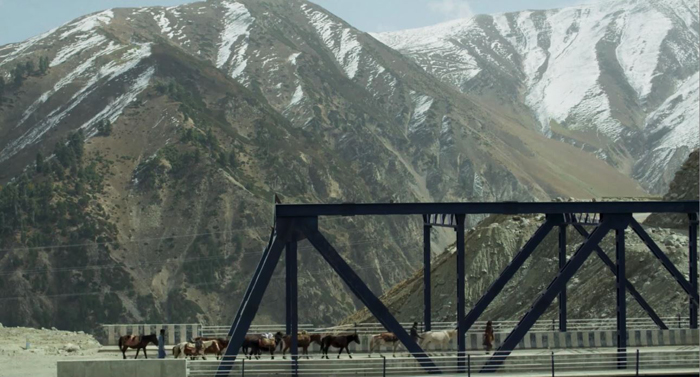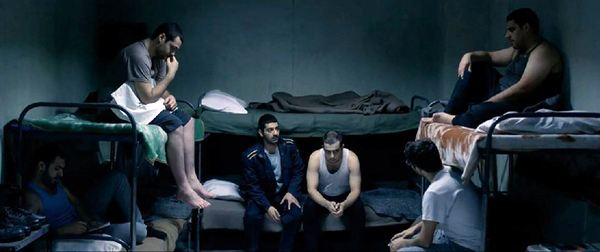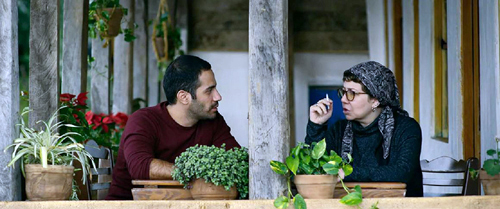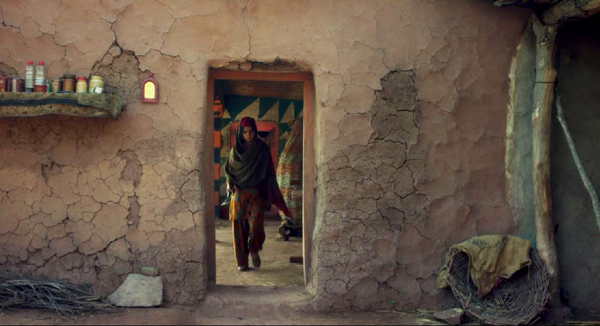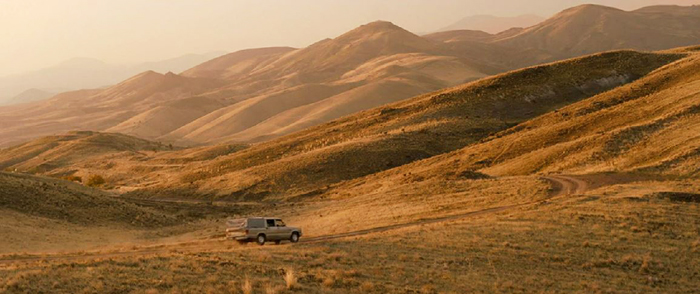Archive for the 'Film comments' Category
A recording of David’s memorial service is now online
KT here:
A memorial service for David was held on May 18, 2024. Although many friends and family members traveled to be present, the service was also streamed live for those who could not.
For those who were unable to do either, a recording of the service has been posted on Vimeo. The link is below.
There was a delay of a few weeks in posting it.
The wait was worth it. Thanks to Erik Gunneson, who also handled the technical aspects of the service itself, the recording is much improved. Erik is a faculty associate in the Department of Communication Arts here at the University of Wisconsin-Madison. He added superimposed titles to identify the speakers and the musical pieces. (The musical pieces were all chosen by David.) He also replaced the music as recorded in the room on the day with music from the original CDs, much improving the quality. Finally he added a lovely quotation from an exchange of email messages I had with our friend Damien Chazelle on the day after David died. Essentially all the information in the program is now in the recording.
When you click on the link, you will be taken to Vimeo. You may be asked to sign in or sign up with Vimeo. This should not be necessary. Just click on the X and the window should close. There is no need to sign up, and there is no password. It helps if you make the image full-screen.
The recording was done by a service used by the funeral service. It started about 17 minutes before the actual service began with the first musical piece. During that 17 minutes, we simply see people arriving and talking and finding their seats. Some of you may want to watch this and spot old friends. At one point one of the funeral staff is visible carrying in a chair. There were not enough chairs for the number of guests, though after more were set out, everyone was able to get a seat in the room. If you don’t want to watch this part, use the slider to go forward to about 17:40. (The music up to that point was supplied by the recording company.)
The entire recording lasts about two hours and twenty minutes.
Thanks to all involved. The service went even better than I had hoped, thanks to our wonderful host and speakers. As you will see, it was a very fitting celebration of David’s life, with much of his humor mixed with the beautiful tributes.
|
Repost of Vancouver: Three gems from Iran and India
The Shepherdess and the Seven Songs (2020).
Since David’s death, this blog has not been updated. I do, however, plan to occasionally re-post old entries if they become relevant to current events in the world of film. I also hope to post new entries as the inspiration strikes me.
This entry deals with Mohammad Rasoulof’s There is No Evil (2020), including information on his troubles with the government at the time. Since he has now gone into exile and had a new film, The Seed of the Sacred Fig, showing at Cannes, I hope this entry serves as a reminder of his earlier films. (Links below lead to other posts on his films, including The White Meadow and Manuscripts Don’t Burn.)
Kristin here:
Among the always bounteous offerings of the Vancouver International Film Festival, my favorite section is “Panorama,” since I enjoy seeing new films from countries all around the globe. Often some of these are from Iran, and the two Iranian films featured this year did not disappoint. The sole Indian film turned out to be an engaging, imaginative tale from an area of the world seldom represented on the screen.
There Is No Evil (2020)
Vancouver is in part a festival of festivals, drawing upon international films already premiered in Berlin, Cannes, Rotterdam, and other earlier festivals. Of necessity, this year’s items come from the pre-Coronavirus festivals, with films from Berlin especially prominent in the schedule. Mohammad Rasoulof’s There Is No Evil, Golden Bear winner as best film, continued the director’s regular contributions to past Vancouver festivals. (For entries on other Rasoulof films we have seen at Vancouver, see here and here.) Christian Petzold’s Undine, discussed by David in the previous entry, won the Silver Bear as best actress for Paula Beer.
There Is No Evil is a deeply ironic title, since its four self-contained episodes deal with one of Iran’s notorious evils, its record for executing its citizens. As Peter DeBruge pointed out in his Variety review, “According to Amnesty Int’l statistics, Iran was responsible for more than half the world’s recorded executions in 2017. The number has since dropped, but the country continues to kill its citizens at alarming rates.”
Often the process of carrying through executions is assigned to hired civilians or is forced to be performed by soldiers. Rasoulof explores various ways in which such executions affect the willing or unwilling people who carry out the orders, as well as the effects on people they know and love. I don’t want to spoil the slow development of these consequences for the characters by describing the plots of each of the four episodes in too much detail. Suffice it to say that the revelation of those consequences are worked up to very slowly and occur dramatically.
The four episodes are shot in quite different styles. Those styles are to a considerable extent determined by the fact that the episodes move to increasingly remote locales.
The first begins in a bustling city and is shot in a bright, ordinary style befitting the depiction of a bourgeois lifestyle, with appointments to pick up spouses and children, shopping trips, and alternately bickering and affectionate conversation.
The second episode abruptly switches to a gloomy, desaturated color scheme of grays and muted browns and greens suited to a film noir (above). This segment begins with a military man assigned to perform an execution panicking because he cannot face killing anyone. During this episode, the tone and even the genre switch abruptly twice, from film noir to thriller to … something else.
The third story has a soldier on leave visiting a family of old friends, including the daughter whom he loves and hopes to become engaged to. Here the film is done in a lyrical, bright style, emphasizing scenes in the lush woods and in the happy rural home of a couple who foster a group opposing the government. Here the soldier talks with the mother of the family.
The fourth episode centers on a couple who have retired to a bee-keeping farm in a remote, mountainous area. They must contend with the visit of a niece, but neither is willing to answer her questions about the past.
I think the style in this part pays homage to Abbas Kiarostami, with numerous shots of the couple’s pickup on winding country roads (see bottom). There’s a specific echo of The Wind Will Carry Us in the motif of the girl’s repeated attempts to find cell-phone coverage to call her parents abroad.
Given the relatively large cast and considerable number of interior and exterior locales, one might wonder how Rasoulof, under an order to stop filmmaking, could make a two-and-a-half hour film critical of government policy. DeBruge’s review, linked above, also comments: “By subdividing the project like this, Rasoulof was able to direct the segments without being shut down by authorities — who are more carefully focused on features — and, in the process, he also builds a stronger argument.” In an earlier Vancouver report, we noted that Rakhshan Bani-Etemad’s Tales (2014) used a network-narrative structure because she could only get permission to make a series of shorts–which she then wove together into a feature.
As DeBruge writes, the reliance on episodic structure does not handicap Rasoulof. The slow accumulation of indifference, regret, and guilt demonstrates that executions have unnoticed, unforeseen, and undeserved effects. The stylistic shifts emphasize the differences in those effects and maintain interest across a long film.
The effectiveness of Rasoulof’s film has not gone unnoticed, however, and a Golden Bear is clearly not enough to protect him. On March 4, he was summoned to begin serving his long-delayed prison term, despite the widespread incidence of COVID-19 in Iranian prisons. (On March 1, three days before the summons, Indiewire published a history of government strictures on Rasoulof.) Many official protests have been launched, and one can only hope that once again the result will be yet another suspension of the enforcement of the sentences against him.
Yalda, a Night for Forgiveness (2019)
Yalda is the second feature by Iranian director Massoud Bakhshi, whose first, A Respectable Family, we recommended as “an unexpected gem” when it played in Vancouver in 2012. Yalda is another film that comes to Vancouver via this year’s Berlin International Film Festival, where it was nominated for a Crystal Bear. It also played at the Sundance Film Festival, where it won the Grand Jury prize in the “World Cinema – Dramatic” category.
The film centers around one episode of a television series, “Joy of Forgiveness,” based on the premise that each week someone convicted of a crime seeks to be forgiven by the victim or a relative of the victim. Although not an actual law, such forgiveness is encouraged in Iran under Islamic law. If forgiveness can be obtained, the criminal is typically absolved of the crime. There are now charities, celebrities (including film director Asghar Farhadi), and other forces working informally to foster forgiveness and free guilty people, though this may include a payment of “blood money” given to the person doing the forgiving. (A real TV show based on this premise, “Honey Moon,” was the inspiration for Yalda.)
In this case, a young, shy working-class woman, Maryam, who had been married to a wealthy older man, has been convicted of killing her husband. She insists, however, that it was an accident. As the film begins, Maryam’s mother brings her to the television station. The young woman is terrified and declares she does not want to participate. But since this would mean a death sentence being carried out, her mother and the production team of the show ignore her protestations and hurry her through the preparations.
Representing the victim is Mona, his daughter, who, as the title of the TV series suggests, is expected to provide the standard happy ending to the show by forgiving Maryam. Mona seems to have reasons to do so, since she would receive the blood money proffered by “Joy of Forgiving” and is planning to emigrate from Iran in the near future.
So far we seem to have a situation familiar from the films of Asghar Farhadi, with two or more people at odds who are gradually revealed to be flawed and to some degree at fault. The situation then typically ends in reluctant understanding between or among the opponents.
As the host interviews the two women, however, he shows a distinct bias toward Mona’s viewpoint. Rather than pleading her case humbly, as the television crew expects, Maryam becomes desperate and accusatory. Her exchanges with Mona grow more heated.
The producers begin to panic. As one points out, this show is occurring on Yalda, a festival held on the day of the winter solstice. The longest night of the year is believed to be unlucky, and traditionally Iranian families gather to eat, tell stories, read poetry, and generally cheer each other up through the night. Seeing a sad ending to the program would badly disappoint the audience.
Telling his story in what is essentially continuous time and at a brisk pace, Bakhshi starts out by sticking closely to Maryam, building up considerable sympathy for her as everyone ignores her pleas and bosses her around. Once the program begins, the increasing hostility of Mona generates a suspense that is well maintained up to the final twists of the ending–twists showing that Bakhshi is not going for a Farhadi-style resolution.
The script is tightly constructed and engrossing, so much so that one could imagine a Hollywood remake–if a plausible legal situation could be devised as the premise.
The Shepherdess and the Seven Songs (2020)
The Shepherdess and the Seven Songs (director Pushpendra Singh) also was shown at the Berlin festival, in its Encounters section. It also won best director in the “Young Cinema Competition (World)” at the online competition for this year’s cancelled Hong Kong International Film Festival.
The film begins with a young man, Tanvir, struggling to lift and shoulder a heavy stone, a traditional test for a prospective husband among a tribe to which whom the beautiful shepherdess of the title, Laila, belongs. Soon a title is superimposed: “Song of Marriage,” the first of the seven songs. These songs are sung over the action–unsubtitled, unfortunately–and give a sense of the story taking place in some old folk tale. (Indeed, a title in the credits declares that the film is “Based on a Rajasthani folk-tale by Vijaydan Detha,” a well-known twentieth-century author of numerous such short stories.)
The fact that the tribes cook over open fires and follow what seem to be old traditions reinforces this impression, until a night scene where some of the men wield LED flashlights. Another title, “Song of Migration,” leads to a the journey of the nomadic tribe into which Laila has married herding their large flock toward the village that is their home base. They pass along modern highways, moving aside for traffic to pass, through landscapes that provide beautiful shots (see the top of this entry). This stretch of the film is lyrical and captivating, thoroughly drawing the spectator into the film.
Abruptly another modern touch, a radio carried by one of the men, thrusts the action into the troubled politics of the present. A newscaster declares, “In the Kashmir Valley protests against Article 5A have escalated.” Two protestors, he says, have been killed. The reference is to Pakistan and India’s dispute over control of Kashmir, and the Kashmiri struggle for independence from both. Laila, it later is revealed, is Kashmiri, while Tanvir’s tribe lives in an area controlled by India.
Laila’s beauty soon attracts the attention of the local Station-master and his subordinate, Mushtaq. They hint that as a Kashmiri she might possibly be a terrorist. This accusation comes to nothing, and Mushtaq’s clumsy attempts to seduce Laila lead to a switch in tone. A series of episodes, each a separate “song,” follow Laila promising trysts with him and then bringing her husband along on a pretext. Mushtaq’s continued gullibility in trusting that each new assignation is made in earnest lends a farcical comic touch to this lengthy passage of the film. At the same time, however, Laila is testing whether her husband, strong enough to lift the stone and win her as his bride, has the moral power to defend her rather than currying favor with Mushtaq by turning a blind eye to his designs on Laila.
I felt that the last portion of the film ran out of the energy it had sustained so well, since Laila is strong enough to turn her back on two unacceptable men but has no apparent sense of where to turn once she has done so. Still, overall The Shepherdess is beautifully filmed, as the frames at the top of this section and of the entry demonstrate. It also tells a thoroughly absorbing story.
So far David and I have reported on six films from this year’s Vancouver festival. Already it has become clear that our accumulated experiences from past years have allowed us to trace the development of promising young filmmakers into great ones and to discover promising new ones whom we hope to encounter at future festivals.
Thanks to Alan Franey, PoChu AuYeung, Jane Harrison, and their colleagues for their help during the festival.
There Is No Evil (2020).
Gone but far from forgotten
Kristin here:
The speed with which the news of David’s death, early on the morning of February 29, 2024, spread has amazed me. I expected many responses: condolences, tributes, and most of all stories of how he had affected people’s lives. I didn’t expect the tidal wave of messages and posts and emails that followed. The authors range from his students and colleagues to casual acquaintances met at film festivals to filmmakers whose work was influenced by his writings. His legacy will clearly be vast and lasting, which to me provides the best consolation for his loss.
David was ill for two and a half years, starting with a cancer diagnosis in June, 2021. Treatment got rid of the cancer, but his chronic degenerative lung disease very slowly progressed. He went into hospice treatment at home last September. Hospice is supposed to last for six months, with an option to renew for another six. He lived almost exactly six months. Though growing weaker toward the end, he remained lucid. We watched a movie together every evening. In the last few days he did not feel up to a complex feature film, so on the night before he died, we rewatched two episodes of The West Wing. His fingers have grown stiff in recent months, but he managed to post a blog entry three days before his death. It was a re-post of an old entry on Hou Hsiao-hsien, with a short new introduction. It was relevant, because the Criterion Collection is streaming some of Hou’s early films, which David loved.
He wanted to die at home rather than spending his last days at a hospice facility, and he did. I was with him. It was brief, and I don’t think he suffered. It happened within a few months of the fiftieth anniversary of when we moved in together in the summer of 1974. He was as wonderful a spouse as he was a scholar and a friend.
His writings live on, of course. Some of them are available free online, linked on the left margin of his website’s main page. He leaves behind video analyses and lectures, too. Some are part of our series “Observations on Film Art” on The Criterion Channel. Others are supplements on Criterion video releases. Less well-known are the five full-length lectures he recorded and posted on Vimeo. Their topics give a sense of his breadth of interests.
What will happen to the blog? Recently we decided that re-posting older entries that seemed relevant to something happening at the time seemed a good plan. With over 1100 entries since our launch in 2006, there are plenty that few know about. I probably won’t blog as often as I used to, but no doubt inspiration will hit once in a while. I promise not to give up the year-end, inexplicably popular lists of the ten best films of ninety years ago. I suspect that 1934 will yield an impressive crop of titles.
This obituary, written by David’s colleagues and valued friends, was first posted on the website of the Department of Communication Arts the the University of Wisconsin-Madison on March 1.
David Bordwell, the Jacques Ledoux Professor Emeritus of Film Studies at the University of Wisconsin-Madison, died on February 29, 2024, at the age of 76 after a lengthy illness. A prolific researcher, dedicated teacher, and passionate cinephile, he guided countless colleagues, students, and film lovers to heightened awareness of the medium’s artistic possibilities. “One thing that I loved and greatly admired about Bordwell was how – with passion, analytic precision and boundless enthusiasm for the medium – he carved out an inviting, sui generis intellectual space that could be enjoyed by scholars and general readers alike,” wrote New York Times film critic Manohla Dargis upon learning of his passing. “He was a paragon of scholarly achievement, yes and of course, but he was also a lot of fun to read – which isn’t something you can say of most academics.”
Bordwell joined the faculty of UW-Madison’s Department of Communication Arts in 1973 immediately after completing his graduate coursework at the University of Iowa (PhD, 1974). He remained at Wisconsin throughout his illustrious career, retiring in 2004, and he continued contributing to the Department’s mission after retirement through emeritus teaching and other activities. He also held visiting faculty appointments at New York University (1979) and the University of Iowa (1980), and in spring 2017 he held the Kluge Chair in Modern Culture at the Library of Congress.
When Bordwell launched his career in the 1970s, film studies was just entering academia, and over the course of three decades at the UW-Madison, as well as a remarkably productive post-retirement, he helped the still-young discipline achieve new levels of respectability and intellectual rigor. Indeed, his scholarly productivity reset the bar for the discipline of film studies. He authored, coauthored, or edited some 22 books and monographs. These included two foundational film studies textbooks written with his spouse and intellectual partner, Dr. Kristin Thompson (Ph.D. UW-Madison, 1977), a multi-talented scholar who has made major contributions to film studies, literary studies, and Egyptology. Bordwell also authored more than 140 journal articles, book chapters, introductions to collections, and review essays.
Later in his career he produced equally valuable material for wider audiences including a lively, wide-ranging blog Observations on Film Art, also in partnership with Thompson, as well as video essays and informative DVD commentaries for The Criterion Collection. And he made himself available at numerous film festivals and public movie screenings as a commentator, sharing his knowledge and enthusiasm with fellow movie lovers. In fact, Bordwell remained a productive scholar until the very end of his life, just a year ago publishing Perplexing Plots: Popular Storytelling and the Poetics of Murder. This exhaustively researched and elegantly written book has been nominated for an Agatha Award and for the Edgar Award, given by the Mystery Writers of America, in the Best Critical/Biographical category.
An inspiring teacher, Bordwell’s classroom skills were acknowledged with the UW-Madison’s Chancellor’s Teaching Award (1984) and a Phi Beta Kappa Teaching Award (2004). He was known for his energized lectures and for his lively, probing graduate seminars. His pedagogical strategy was not so much to impart knowledge as to draw it out from students, yielding fresh insights on whatever film, director, or theoretical issue was on the agenda for that day. Professor Maria Belodubrovskaya (University of Chicago) speaks for generations of former Bordwell students in recalling the sense of participation available to all members of a Bordwell class. “What struck me about David’s teaching was that in the classroom he did not behave as a big-time scholar but as more of a leader,” she recalled. “Everyone was treated as no less curious and observant than the instructor himself.”
Bordwell also provided a professional model that benefitted many of the Communication Arts graduate students who eventually entered higher education. UW-Madison Professor Emeritus Vance Kepley’s memory of his very first experience in a Bordwell graduate course is indicative: “It was something of an epiphany. By the end of the first class, I thought, ‘This is exactly how film studies should be taught. It’s what I want to do, and I want to do it just as well.’ Of course, I never came close to duplicating David’s casual brilliance, but years of trying made me a better teacher.”
The impact of Bordwell’s graduate mentoring can be suggested by both the quantity and quality of the doctoral dissertations he supervised. At UW-Madison, he directed 33 dissertations, each of which helped launch a productive career, and 17 dissertations were published as career-enhancing monographs. Bordwell’s dissertators could count on him to provide exacting but encouraging guidance through the always-arduous process of bringing forth a polished manuscript. “David pounced on every chapter as soon as I submitted it for review,” remembers Professor Richard Neupert (University of Georgia). “Within days he returned the manuscript covered with detailed and often witty commentary, along with a thoughtful, typed summary with warnings, suggestions, and praise. More than a great mentor, he was a fellow traveler.”
Bordwell’s research program consisted of three principal strands. The first is composed of stylistic analyses of individual films or directors, most notably The Films of Carl-Theodor Dreyer (1980), the monumental Ozu and the Poetics of Cinema (1988), The Cinema of Eisenstein (1993), and detailed essays on Louis Feuillade, Kenji Mizoguchi, Theodoros Angelopoulos and Hou Hsiao-Hsien grouped in the volume Figures Traced in Light: On Cinematic Staging (2005). The introductory college textbook Film Art: An Introduction, written with Thompson, also contributes to this strand. First published in 1979, it is now in its thirteenth edition and will continue under the authorship of Professor Jeff Smith (UW-Madison). It has been translated into ten other languages, with additional translations forthcoming.
The analysis of national film styles and modes of film production constitutes the second strand of Bordwell’s research. These studies incorporate primary-level documentary research on the structure of film industries, film technology, and the conditions of production. The most important work in this category is The Classical Hollywood Cinema: Film Style and Mode of Production to 1960 (1985), written with Thompson and Janet Staiger (William P. Hobby Centennial Professor Emerita, University of Texas at Austin). A massive research undertaking, it incorporates stylistic analyses of a random sample of one hundred films, interviews with veteran cinematographers and other craft workers, and careful reading of film industry trade papers and industry technical reports. It seeks to define the group style of classical Hollywood in terms of a range of stylistic options which were delimited by the state of filmmaking technology at any given point, as well as by the craft practices and conventions internalized by filmmakers. The methodology was later used in another widely successful textbook, Film History: An Introduction, also coauthored with Thompson and designed to introduce students to a broad spectrum of national cinemas. The sole-authored Planet Hong Kong: Popular Cinema and the Art of Entertainment (2000) examined a small but hugely successful film industry from the 1970s through the 1990s, focusing on stylistic norms and narrative strategies that distinguished Hong Kong cinema from Hollywood.
The third strand of Bordwell’s research involved theorizing the role of the film spectator in the movie-viewing experience. Bordwell’s ground-breaking Narration in the Fiction Film (1985) proposed the idea that viewers integrated perceptual information with higher order cognition to construct the film’s story. For Bordwell, spectators were active makers of meaning who drew on their understanding of cinematic conventions, their knowledge of different types of stories, and their real-life experience to comprehend the various visual and audio cues given to them by the film. With this and several subsequent publications, Bordwell helped encourage a robust line of scholarship in cognitive film studies, an approach that brought together analytic philosophers and psychologists in developing a model of spectatorship that amalgamates aspects of art, culture, and even biology.
Bordwell’s many professional honors attest to the respect he earned in the international scholarly community. He was awarded honorary doctorates from the University of Copenhagen (1997) and from Lingnan University in Hong Kong (2023). Other major international awards include a University of Auckland Hood Fellowship (New Zealand), an Anthology Film Archives Award (United States), an Excellence in Asian Film Scholarship Award (Asian Film Society, Hong Kong), and the aforementioned Kluge Chair. At UW-Madison, Bordwell was selected for a prestigious Wisconsin Alumni Research Foundation Professorship (1990) and for a Hilldale Distinguished Professorship (2001), as well as a Hilldale Award in the Humanities (2001) and a senior fellowship at the Institute for Research in the Humanities (1993-98).
Bordwell’s love of cinema emerged when he was a child, living on a remote farm in upstate New York, far from any movie theater. In his rare moments away from school and chores, he nourished his cinephilia by watching films on TV and reading books about film starting at the age of 12. Bordwell made his way to the State University of New York at Albany, where he studied English literature. He then did his graduate studies in Speech and Dramatic Arts, with a concentration in Film at the University of Iowa.
Notice of his passing prompted glowing tributes for Bordwell from prominent filmmakers and intellectuals outside the academy who valued his myriad contributions to world film culture.
David Koepp, critically acclaimed screenwriter and director (Jurassic Park, Mission Impossible, Premium Rush)
“David’s genius for analyzing Hollywood narrative was an inspiration and a goal for me in my own work, and it reflected in the work of anyone who read him. He had a boundless generosity toward the medium and found value in everything he saw, at all levels of artistic accomplishment.”
Damien Chazelle, Oscar-winning writer and director (La La Land):
“I learned more about film from reading David Bordwell than from any other writer. To me he was America’s André Bazin, a thinker and historian who massively expanded the field and found a way to marry theory and criticism in a wholly new way. Narration in the Fiction Film changed how I think about storytelling in film. Figures Traced in Light changed how I think about framing. The Way Hollywood Tells It changed how I think about Hollywood. He was a giant, and multiple generations of filmmakers, critics and theorists (for ultimately we are all in this together) owe him a huge debt.”
Kim Hendrickson, Executive Producer, Criterion:
“David and I spent many hours together recording his analyses for the fifty episode Observations on Film Art series we created for the Criterion Channel. He was a champion for movies not because he was superb at analyzing form – he was the best – but because movies were his life force. I, and so many colleagues at Janus and Criterion, are indebted to him for his brilliance, generosity, and friendship.”
James Schamus, award-winning screenwriter, producer, director, and professor (Crouching Tiger, Hidden Dragon; Brokeback Mountain):
“As a filmmaker, I can describe David’s friendship as unnervingly generous. His astonishing critical intelligence never got in the way of his enthusiasms, and his enthusiasms never dampened his analytic regard; they were functions of each other. This meant that when talk came around to one’s own work, the effect was something akin to getting a loving bear hug from a nuclear-powered microscope. There will never be another like David again.”
To an international community of filmmakers, film students, and cinephiles, David Bordwell was the most respected film scholar of his generation. But to his very wide and ever-widening circle of friends, he also was a warm, witty, unaffected companion. To the thousands of students, colleagues, and movie-lovers who sought his counsel outside of the classroom, he was generous with his time and knowledge, and in social gatherings he graciously cultivated new friendships with individuals he was meeting for the first time while also reconfirming his appreciation for friends of long-standing. He could tailor his one-on-one conversations to whatever topics were of interest to the other party, and one usually came away from such chats with the feeling that, besides being a keen conversationalist, he was also a wonderfully attentive and appreciative listener. All who knew David Bordwell personally will miss his kindness, goodwill, and boundless congeniality, as well as his professional wisdom.
Survivors include his wife, Kristin Thompson; his sisters, Diane Bordwell Verma and Darlene Bordwell; his nephew, Sanjeev Verma, and his niece, Kamini Verma.
News about PERPLEXING PLOTS
Edgar Award© Mystery Writers of America.
DB here:
Some good news for Perplexing Plots. It’s gotten positive reviews in various places; they’re sampled on its Amazon page. Most recently, Geoffrey O’Brien has written a very generous review for the New York Review of Books (February 8, 2024). He has, needless to say, kind words for Martin Edwards’ monumental Life of Crime as well. More broadly, he shares his insights into the appeals of mystery fiction as a genre.
Meanwhile, Perplexing Plots has been nominated for two awards. One is for a 2023 Edgar, given by the Mystery Writers of America, in the Best Critical/Biographical category. This honor is one I had scarcely dreamed of. The MWA is the most famous and influential organization of practitioners of the craft. The book is up against high-quality competition: biographies of Mickey Spillane, James Ellroy, and Edgar Allan Poe, all by esteemed experts. The awards will be presented on 1 May.
Perplexing Plots has also been nominated for an Agatha, to be awarded at the annual Malice Domestic conference of fans of classic whodunits (26-28 April). This is especially gratifying to me, since one theme of the book is the enduring significance of the traditional puzzle mystery, even in an era when noir fiction and suspense thrillers garner so much attention.
In all, I appreciate the recognition that the book has received and hope that readers find it worth exploring. Thanks as well to the staff of Columbia University Press for publishing the book.













